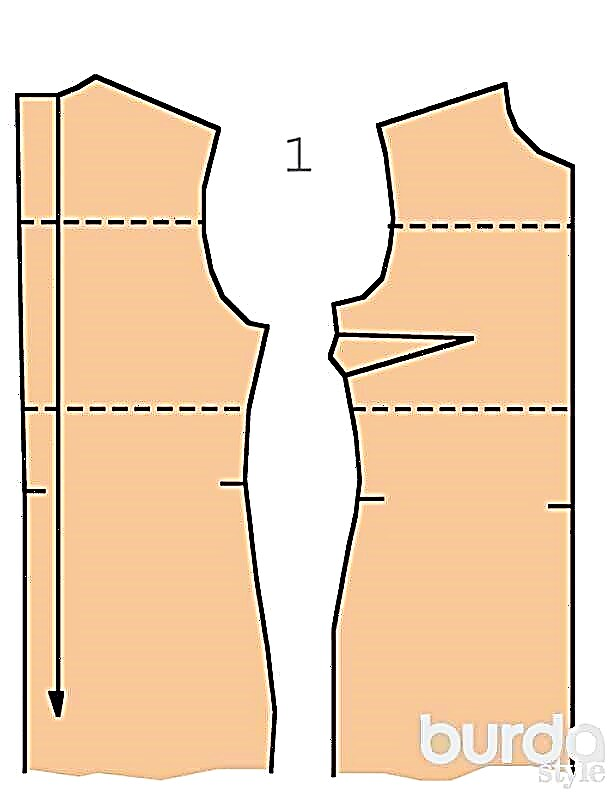If you are just starting your way into the wonderful world of sewing, you are unlikely to be able to avoid some mistakes, because they are known to learn from them. But we will show you how to minimize them.

1. Fear has big eyes
And those who are afraid to start sewing, and those who cut “boldly” and immediately, without thinking, do the wrong thing. It is easy to get rid of this mistake if, before embarking on the first sewing project, practice on the layout and sew your first product from unnecessary fabric. Otherwise, how can one say that you will not succeed if you have never tried?
2. Remove the pattern "by eye"

In order not to make a mistake with the size of the pattern, first take your measurements (it is better to ask someone to help you with this), write them down and compare them with the burda size chart. If you clearly fall into one of the sizes of the burda table - great. But if the measurements "walk" between several values, you should not rely on luck and choose the size approximately. Transfer the contours of the pattern to tracing paper between two, if necessary, three sizes. In those places where there are discrepancies between sizes, draw lines smoothly. For example, the top is the 38th size, in the waist area go to the 36th, hips - again go back to the 38th. Be sure to transfer all the values to the details of the paper pattern - the direction of the shared, mark alignment of parts, the line of the middle of the front and back, etc.
3. Measure seven times, cut one - this is not for me!

A very common mistake is when the contours of the details of the paper pattern are incorrectly transferred to the fabric, the footage of the fabric is incorrectly calculated and, moreover, these errors were detected after cutting! To avoid such a mistake, before buying fabric, pay attention to the footage indicated in the instructions, and before transferring the paper details of the pattern to the fabric - to the layout plan. Be especially careful if the fabric is coupon, with a pattern having the same direction or fabric with a pile.
4. Can be sewn from any fabric

Yes, you can, but on condition that you have enough experience. To comprehend the basics of sewing still follows with simple fabrics that do not require a special approach and knowledge. Prefer plain cotton or linen.
5. A straight line is easy!

This is an absolutely erroneous assurance. If the line is straight, this does not mean that you will get it the first time. This skill must be trained constantly. Start with plain paper if you want. At the same time, threading the machine is not necessary. Just lay a straight line along the marked boxes. Then go to the fabric, sew napkins, an apron, sew a sheet or tablecloth, the more practice, the better.
How to learn to sew a straight line
6. I know my car

This should not be an allegation. You should easily navigate and know the basic and simplest functions of your sewing machine. Be sure to read the entire manual at least once from beginning to end, and keep it handy.
How to choose the first sewing machine
7. Hurry - you make people laugh

Haste is perhaps the most important mistake a beginner seamstress. Although experienced craftswomen also encounter it, when for unknown reasons they suddenly put the urgent completion of the project at the head of the project. The desire to do everything as soon as possible, skipping some steps and ignoring the recommendations of the instructions, sometimes lead to a sad result - a damaged product. Well, if it can be strung up and correct the mistakes made. Therefore, before grinding the details, sweep or chop them with tailor pins. Start sewing at a slow speed. If the seam is straight, gradually increase the speed, but in no case lose your vigilance. If the seam is oblique or curved, perform it without increasing the sewing speed.
How to sew over tailor pins
8. No fitting

Many ignore this point, and after all the details are bold, they begin to grind them. This is permissible only if you are sewing a product not the first time, according to a proven pattern and your size has not changed. In all other cases, fitting must not be neglected! It is the fitting that makes it possible to see and eliminate defects before the product is sewn, allows you to adjust the model to the figure, makes it clear how the future dress will sit on you, for example. Thanks to the fitting, you can make all the necessary changes to get the perfect result.
9. We dispense with the decanting of tissue

This error most often arises from ignorance. But if you consciously skip this mandatory stage of fabric preparation, the result after the first wash of a new thing will surprise you greatly - the product can give a pretty strong shrinkage. And it will be impossible to fix it. Therefore, before cutting and sewing, decorate the fabric.
How to decorate fabric
10. And so it goes, still no one will notice
These phrases indicate negligence in the work, do not allow this. If something doesn’t work out somewhere, don’t leave it as it is, put it apart and perform this step again. Healthy perfectionism has not harmed anyone. Unzip and redo so many times until you are satisfied with the result.

Do not leave seams untreated, even if you do not have an overlock, use the zigzag stitch that is found in almost every sewing machine.
6 ways to process seams without overlock
Unsecured seams tend to diverge. Therefore, at the beginning and end of the seam, always bind, either use the backseam function, or manually fasten the stitch and hide the thread tails. If manual bending is preferred in a particular model, then do it manually.
12. WTO

Wet heat treatment or ironing is an integral part of the sewing process. Many novice seamstresses believe that this is not important, and only the finished product is ironed. Although at almost every stage it is required to iron the seams, iron the parts, iron the collar, iron the non-woven fabric, etc. Do not neglect this simple rule, because in the end the appearance of the finished product will depend on the WTO.
Ironing correctly means good sewing!
13. Unfinished products
This is a scourge not only for beginners, but also seamstresses with experience. It doesn’t matter what reason forced you to put the unfinished product in a long drawer - the fabric or the chosen model didn’t like, or you simply burned out for this sewing project. You have to make an effort on yourself and finish or alter the thing, if you really don’t like it at all.

Make it a rule - do not start a new sewing project if you have not finished the previous one. It is difficult but doable. Having set yourself the task of completing the imperfection, with each line you will be approaching a new project. And in order to get rid of the oppressive “I am completing it through force”, think about who you could sew this thing for and things will go much faster.
Still, you can’t do without errors!
No matter how prosaic this may sound, the fact remains the fact, and mistakes still happen. Most importantly, do not be discouraged, even if the thing is hopelessly spoiled. Learn a lesson from this, believe me, you won’t repeat such a mistake again, bad experience will teach you that it’s certainly not necessary to do this. Use the tips, look into the instructions again, especially if in doubt, follow new steps, for example, loops, stitching, a pocket on unnecessary shreds.
How to learn to sew: tips for beginners
Article author: Julia Dekanova
Photo: pixabay



